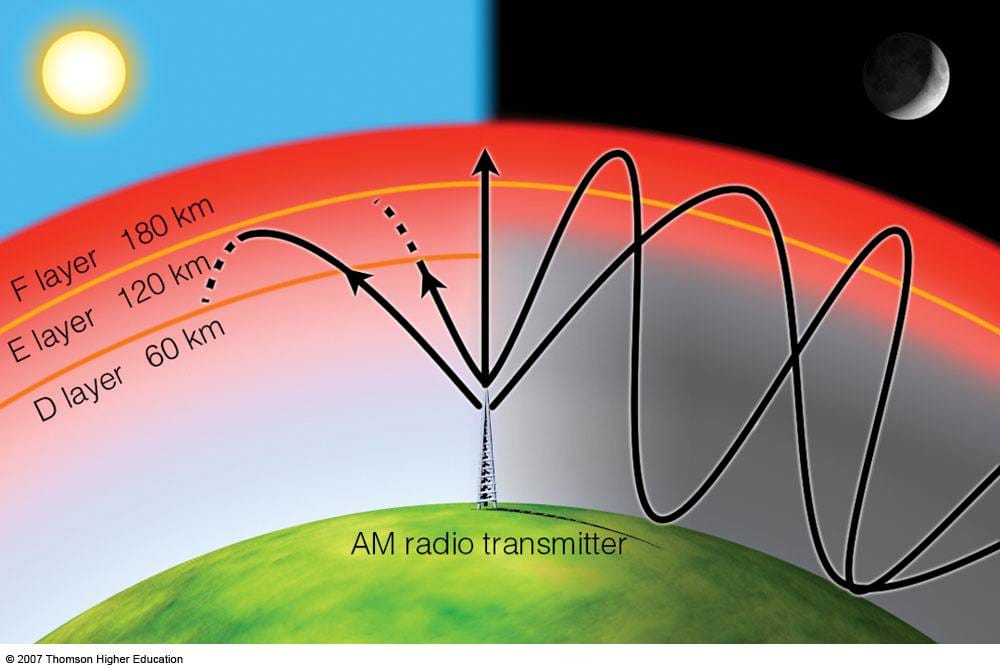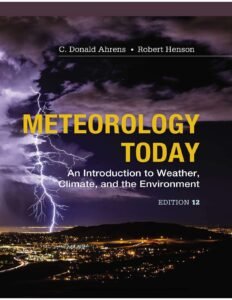Vertical Structure of the Atmosphere
Air molecules (as well as everything else) are held near Earth by gravity. This strong, invisible force pulling down on the air squeezes (compresses) air molecules closer together, which causes their number in a given volume to increase. The more air above a level, the greater the squeezing effect or compression.
As air density is the number of air molecules in a given volume, therefore air density is greatest at surface and decreases upward. The density of air (or any substance) is determined by the masses of atoms and molecules and the amount of space between them.

As air near the surface is compressed, so air density decreases rapidly at first, then more slowly as we move up from the surface.
The weight of all the air around Earth is a stag gering 5600 trillion tons, or roughly 5.08X1018 kg. The weight of the air molecules acts as a force upon Earth. The amount of force exerted over an area of surface is called atmospheric pressure or, simply, air pressure. As the number of air molecules decreases with height, so atmospheric pressure decreases with increasing height. Like density, air pressure decreases rapidly at first, more slowly at higher levels.
At sea level, the average or standard value for atmospheric pressure is
1013.25b = 1013.25 hpa = 29.92 in Hg
At an altitude of 50km, the air pressure is 1mb, which means 99.9% of all the air molecules are below 50 km.

Layers of the Atmosphere
We know both air pressure and density decrease with height- rapidly at first, then more slowly. But air temperature has a more complicated vertical structure.

Air temperature normally decreases from Earth’s surface up to an altitude of about 11 km, which is nearly 36,000 ft, or 7 mi. This decrease in air temperature with increasing height is due primarily to the fact that sunlight warms Earth’s surface, and the surface, in turn, warms the air above it.
The rate at which the air temperature decreases with height is called the temperature lapse rate. The average (or standard) lapse rate in this region of the lower atmosphere is about 6.50C for every 1000 m or about 3.60F for every 1000-ft increase in altitude. (Keep in mind that these values are only averages)
If air becomes colder more quickly with height, then the lapse rate steepens and when the air cools slowly with increasing height the lapse rate is less. Occasionally the air temperature increases with height, producing a condition called Temperature inversion. The lapse rate fluctuates, varying from day to day, season to season, and place to place.
When the temperature decreases with height, the lapse rate is positive (in Troposphere and Mesosphere).
When the temperature increases with height, the lapse rate is negative (in Stratosphere and Thermosphere). This region of circulating air extending upward from Earth’s surface to where the air stops becoming colder with height is called the troposphere— from the Greek tropein, meaning “to turn” or “to change.”
Above 11 km the air temperature normally stops decreasing with height. Here, the lapse rate is zero. This region, where, on average, the air temperature remains constant with height, is referred to as an isothermal (equal temperature) zone.
The boundary separating the troposphere from the stratosphere is called the tropopause. The height of the tropopause varies. It is normally found at higher elevations over equatorial regions, and it decreases in elevation as we travel poleward. The tropopause is higher in summer and lower in winter at all latitudes.

(green line), and electrical properties (dark blue line). (An active sun is associated with large numbers of solar eruptions.)
In stratosphere the air temperature begins to increase with height, producing a temperature inversion condition. This inversion restricts the air of the troposphere to spread out vertically. the air temperature is increasing with height, the air at an altitude of 30 km (about 100,000 feet or 19 mi) is extremely cold, averaging less than -460C (-510F).
The reason behind this increase in temperature in stratosphere is the absorption of UV rays by ozone. Above the stratosphere is the mesosphere. The air is extremely thin here and atmospheric pressure is quite low. With a temperature of -90°C, top of the mesosphere is coldest place of our atmosphere. The hot layer above mesosphere is the thermosphere. Here the oxygen molecules absorb the energetic solar rays, warming the air. Although the temperature exceeds 5000C in thermosphere, but a person shielded from the sun would not necessarily feel hot because there are very few molecules are present in this region to bump against something.
Above thermosphere many of the lighter, faster-moving molecules travelling in the right direction escape the earth’s gravitational pull. The region where atom and molecules shoot off into space is called Exosphere. Below the thermosphere the composition of the atmosphere is uniform (78% nitrogen and 21% oxygen). This lower well mixed region is called homosphere.In thermosphere due to very less number of air molecules stratification of air molecules (heavier atoms settle to the bottom and lighter float at the top). This stratified layer is called heterosphere.
Ionosphere
Ionosphere is an electrified region in the upper atmosphere, where large concentration of ions and free electrons exist. The ionosphere starts about 60 km above the earth’s surface. So major portion of the ionosphere is in the thermosphere. The ionosphere plays an important role in radio communication. The lower D region/layer absorbs the AM radio waves, thereby weakening the same. During night the D regions disappears and AM radio waves are able to penetrate higher into the ionosphere (E & F regions). After reflecting from this AM waves are able to travel for many hundred kilometers at night. Layers of the atmosphere based on temperature, composition and electrical properties are given in

Important elements of climatology
- air temperature—the degree of hotness or coldness of the air
- air pressure—the force of the air above an area
- humidity—a measure of the amount of water vapor in the air
- clouds—visible masses of tiny water droplets and/or ice crystals that are above Earth’s surface
- precipitation—any form of water, either liquid or solid (rain or snow), that falls from clouds and reaches the ground
- visibility—the greatest distance one can see
- wind—the horizontal movement of air

